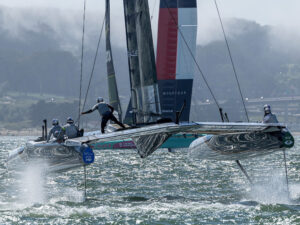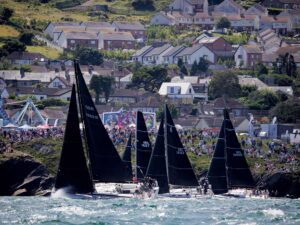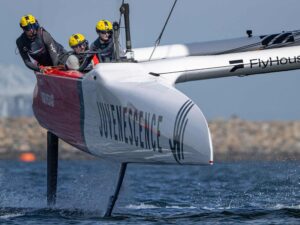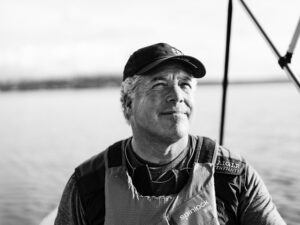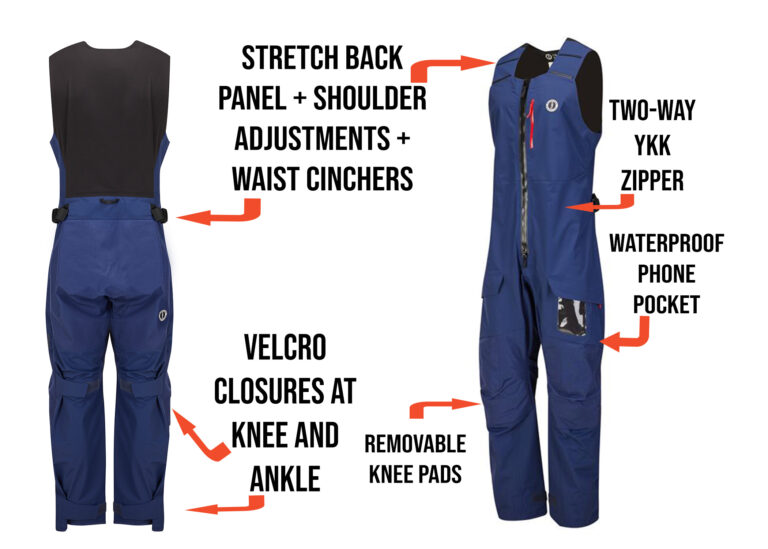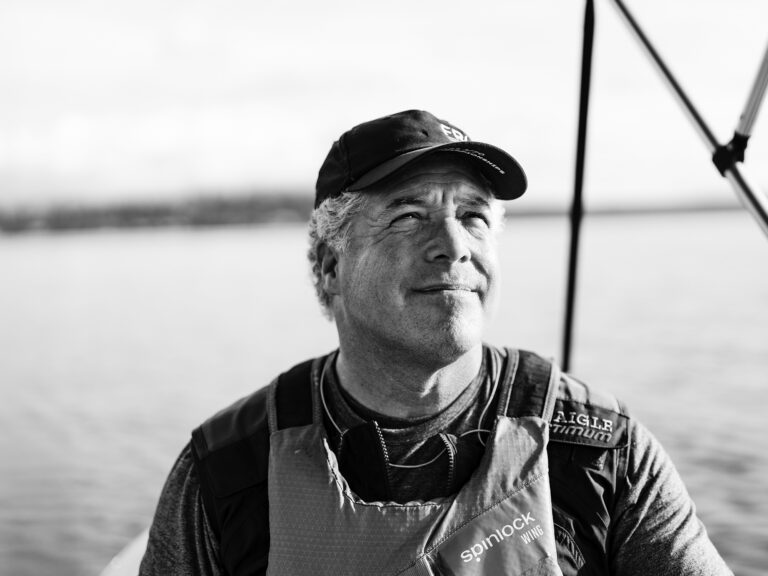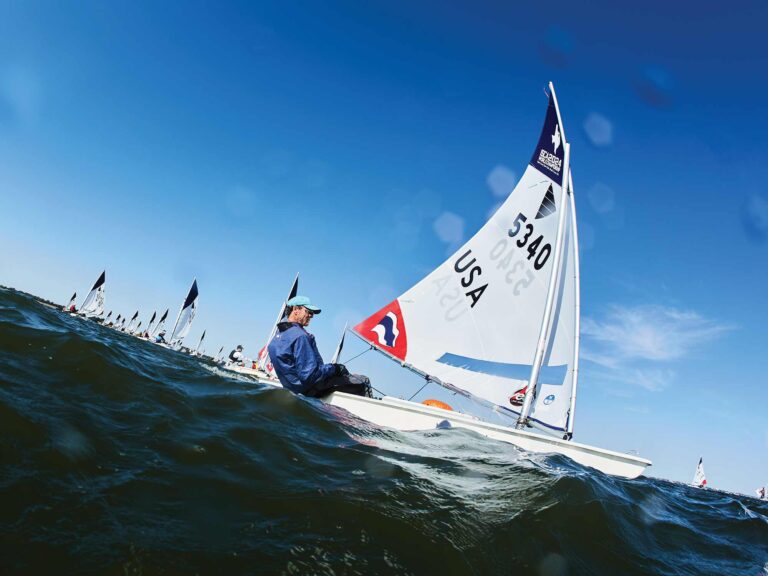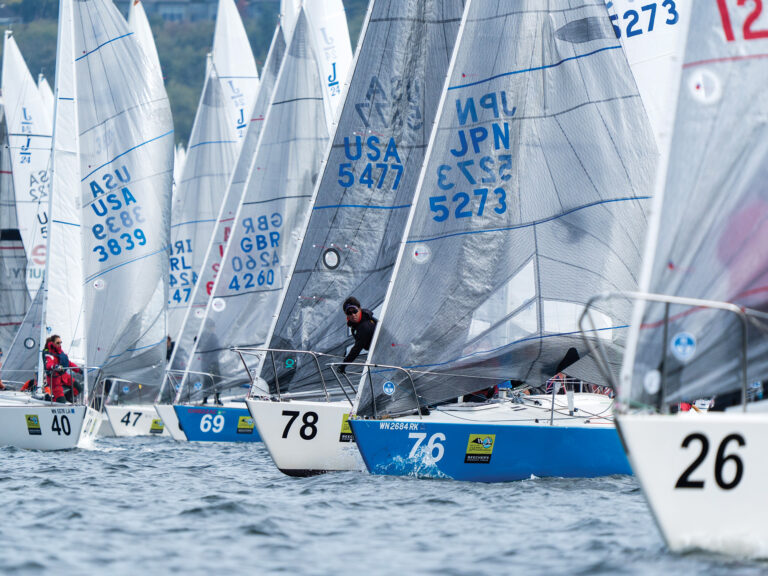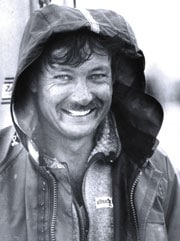
Sailing World: Where did you grow up sailing in Australia?John Bertrand: On Port Philip Bay, in Chelsea, about 20 miles southeast of Melbourne. In fact our house bordered on the beach. We sailed out of a club called Chelsea YC.SW: What type of boats did you sail?JB: I sailed in a junior training boat called the Sabot (Sabo) or Sabot (Sabut) as you guys call it. They didn’t really have any junior training when my brother and I started sailing. I was 8 and my brother was 10. My uncle looked around for all different types of boats and we built the Sabot. My uncle sailed at the yacht club; my parents had no involvement in sailing, but my grandfather had been vice commodore and my uncle was a very keen racer.SW: Was your uncle a mentor of sorts?My brother and I started together, and my uncle was very much of a mentor for us. He introduced us to the joy of sailing with no pressure. SW: Where did the competitive drive come in?JB: That started in my mid-teens. In the early stages when I first started sailing I had no interest in racing, not that we had the opportunity because there were no other Sabots around. I just enjoyed the cruising, watching the bubbles go past the gunnel, and mucking around in boats, which is a wonderful thing to have.SW: What kind of boat were you sailing when you began racing?JB: The Sabot started to become popular when I was more like 13. I was competing and doing well, winning state championships. And then I moved into the VJ, which is an intermediate class yacht, with my brother. It’s a 12-foot junior class, very high performance, and the total weight of the hull was 90 pounds, with two hiking boards. So these things were a little bit like a minor version of an 18-foot skiff. We spent a large number of hours out on Port Philip Bay upside down trying to figure out how to get this high-performance machine upright and airborne again. That was really the basis for the start of my sailing. When I was 16, my crew and I went across to Perth and won the Australian Junior VJ Championships, which kind of launched me. SW: Let’s keep going from there a bit.JB: I then moved into the lightweight Sharpie class, which is not unlike a Flying Dutchman. They were the senior racing class in Australia in those days, and the Sharpies were the most competitive centerboarder in the country. I went on to win the junior and then the senior national champs. SW: How old were you?JB: I was then 19 and 20. I stayed in the Sharpies through my career at Monash University in the Melbourne area.SW: At that point did you have your sights set on possibly going to the Olympics?JB: Well, the dream was the Olympic Games and America’s Cup if you read the magazines and listened to the interviews and so on. Really, my world was Sharpies because they were the hot class and the most active racing. The Olympic Games classes were very low profile in Australia, but you’d get 100 boats out racing in the Sharpies class. That’s where the top sailors were racing. Actually I went from the Sharpies into the America’s Cup when Sir James Hardy asked me to consider trying out for the America’s Cup. As a result, the very first keelboat I sailed on was Gretel II. I remember stepping onto the deck of the boat and wondering why didn’t it tip over a little bit. With 20 tons of lead, the dynamics were pretty different. I was 22 then, and I sailed as a port trimmer on Gretel II in the 1970 America’s Cup Challenge.SW: Which brought you to North America.JB: Within that period I was able to gain a scholarship to study at MIT in Boston. Rasa and I had just gotten married before we came to the States for the America’s Cup. She was a nurse, and she supported me going through MIT. We had absolutely zero financial resources. I had a teaching assitant’s scholarship that paid for some of my fees at MIT and that’s about all.SW: Once you were there you started thinking more about the Olympics?JB: While at MIT I discovered the intense joys of match racing on the Charles River at the MIT sailing club and also the frostbite racing up at Marblehead every second Sunday. My professor Jerry Milgram-crazy man, brilliant-was a key part of our life. I used to race his Interclub dinghy. That was a real eye opener in terms of intense North American sailing; it was the first exposure I had in terms of dinghy sailing. In Marblehead I met Robbie Doyle and his wife Janet. Robbie introduced me to the Finn; I ended up borrowing one from MIT and going to Toronto for the Gold Cup in 1971. SW: How did you make out?JB: I got 8th out of 110 boats. It was the first regatta I’d raced a Finn in so that gave me the impetus to consider going to the Olympic Games for Australia.SW: How many years were you at MIT?JB: It was a two-year Masters of Science within the department of naval architecture, and I condensed it down to 18 months so I could get back to Australia and go for the Olympic trials.SW: You did the Finn campaign. What did that involve?JB: I spent a month on San Francisco Bay on the way back. I trained with Ed Bennett there. I’d sail every day by myself and Ed would come out on weekends. Back in Australia I won the selections and did the European circuit and met the other Finn sailors from Around the World. That year I was second in the Gold Cup to the great Jorge Bruder in Anzio, Italy. At the Olympic Games that year, Serge Maury from France won in relatively fickle conditions for Kiel. Most people including myself were expecting strong winds and typical of a regatta, it’s never like it’s supposed to be. So I got the leather medal, fourth place, which is worse than last.SW: So you had to try again, but you did another America’s Cup in the meantime?JB: Yes. Back to Australia, I worked for Ben Lexcen in the design of Southern Cross. I worked in Sydney and over in Perth with that project and came back to the U.S. in ’74 as tactician and mainsheet hand on Southern Cross. Afterwards I swore I’d never do another America’s Cup again. That was it. Got blown away yet again. SW: You probably needed a job, too?JB: I rang up David Forbes, a good friend of mine who was the Olympic gold medalist in the Star class in 1972 for Australia. He was co-owner of North Sails Australia, and he suggested I look at the sailmaking industry. I called Lowell North, and he suggested that I meet Peter Barrett in Pewaukee, Wisc. So rather than go home, Rasa and I took off for Pewaukee. Rasa took one look at the town and said, “We’re not going any farther.” She loved the place. And I met not only Peter Barrett but Peter and Olaf Harken and Buddy Melges. We had two wonderful years in the Midwest.SW: You’re now in your mid-20s?JB: And developing the basis for setting up North Sails in Melbourne after the 1976 Olympic Games. I had a dual purpose. One was to develop the knowledge to set up a new business in Australia and second was to compete again for Australia in 1976. I used that time in Pewaukee as my Finn base. Within that period I also sailed Golden Dazy as tactician in in the Canada’s Cup, which we won, and I helped the Harkens develop their Finn production. Their very first boat was called POP 1, which means Princess of Pewaukee. That was the first in a long lineage of very successful Vanguard Finns. SW: You must have honorary citizenship in Pewaukee.JB: We went back 20 years after and it was as if there was no yesterday. We picked up the same conversations. I also remember racing ice boats in the winter and I was fourth in the DN NAs.SW: You came in contact with many bright people over this period, from Ben Lexcen and Jerry Milgram to Peter Barrett. Who do you think of as your mentors in this period and what kind of lessons did you take away that made a difference down the road for you?JB: All of them were very interesting personalities. Look at Benny, his ability to think outside of the box as a result of only have three years of formal education. He had no restrictions in his thinking and intuitively he was a brilliant man. From my perspective he was a Leonardo da Vinci born in the wrong era, only in the sense that he didn’t have benefactors to the degree that Leonardo did. That was a wonderful time and he was a mentor in many ways; he was also stepfather of our eldest son, so we were very close.People like Jerry Milgram, the walking talking mathematician whiz kid-an absolute renegade, riding around Boston in the snow on his bicycle, sometimes with no shoes on. He’d come into our house and Rasa would make him a cup of coffee and warm him up. Or he might be going around on crutches because every time we saw him he’d broken his leg or whatever, falling over something. But he was absolutely brilliant; he was the first one to work on advanced software for flow around sails. The work I did with Jerry down in the basement at MIT developing new sail shapes for America’s Cup and whatever was interesting and stimulating.Peter Barrett was then vice president of North Sails worldwide, and that he had such a love of sailing and love of the sport and love of people and could still be such a successful competitor in his own right was very influential on me. And then you have Peter and Olaf Harken: Peter graduated as a trained accountant and Olaf graduated in engineering, and they did a total reversal of roles in their business. Spending time with these people and others around them within the Harken empire, building from nothing and doing everything on a handshake, we saw an absolute trust-no real contracts and all still done on a handshake agreement. That was very influential: to see these world class thinkers evolve their businesses with an integrity that was part and parcel of their lives.Buddy Melges was probably the most influential in terms of my pure sailing activities-seeing his empathy with the wind and water on Lake Zenda, and his ability to naturally track the wind and the oscillations and be at one with the environment that he was racing in, whether it was soft water or hard. And the way he described it all and had such a love for high performance and his ethics around that. We learned that he retired from the world Flying Dutchman championships on the Great Lakes after he observed various countries cheating; in. He pulled out because he’d had enough of that type of environment. All those different people were very influential in giving me, a boy from Chelsea, Victoria, Australia, an international rounding of how the world worked. I was very fortunate to have come across so many superb people in their own rights. In hindsight, our time in the Midwest in particular and the sailing I did via North Sails was extremely important for me in setting up the ’76 Olympic Games and also going on to win the America’s Cup in ’83.SW: Could you name the one most important thing that you took from those experiences to making the difference at the Olympics and then coming back from being down 1-3 in the America’s Cup?JB: Leading into the Olympics what made the difference was really the highly competitive nature of the American college sailing scene and its dog-eat-dog type of environment that fine-tuned my ability in tight fleet or match racing. That was very influential on me, plus the ability to roll with the punches, and not to be so serious that it would burn people up. It was just a natural extension of a Saturday or Sunday afternoon of sailing. But the intensity of it was really startling compared to anything I’d seen in Australia. It was important to be at ease with that environment. I took that and of course the lessons from doing all the Finn Gold Cups and the Finn North Americans, which I won one year with POP1 down in Florida.What I learned from the ’76 Olympics was that it was just as easy in my opinion to have won the gold medal as the bronze-which I did win-and the difference was what was between the ears, the mental state and how much at ease you were in the high level of competition or not. Jochen [Schuemann] was the coolest sailor I’d come across at that stage. He won the gold and he’s gone on, of course, to do unprecendented things in the world of the Olympic Games.Those elements, in hindsight, were very key to going into the America’s Cup in 1983. When we were 3-1 down, I remembered how cool Jochen was during the ’76 Olympics and observing that and just generally the international building blocks I’d had over all those year was fundamental to our ability to come back from the abyss. SW: You knew you just had to sail one good race at a time.JB: At 3-1 down, the consequences of winning or losing were huge. The consequences of winning, of course-national hero. The consequences of losing, never necessarily want to go back to Australia to face the music. We had to have the ability to zero in and get rid of the consequences and get on with the job at hand, and that was to win the first cross off the line, get to the first mark in first place, and so on. In other words, to win the next race and put all the powers of concentration on that. Life beyond that was irrelevant, and to have that power of focus was fundamental. That was a key part of our ability to go from 3-1 to 3-2 to 3-3.Then of course, the incredible hype at 3-3, where the U.S. was starting to come alive. On the U.S. television, everything was baseball, I’m told at least, and the news announcements of this little event down in Newport, R.I., went from a trivial type of comment that the United States is in command yet again in the America’s Cup to almost a sense of disbelief that perhaps there could be a race. On the final day the networks were flying in equipment from all over the country. The whole thing was transformed in terms of people’s awareness.SW: And you just had to go out there and do the same thing again: try to win the race.JB: Everything else was irrelevant. It all came back to that ability to put a race together.SW: Is winning the America’s Cup your favorite memory of your racing career or is it something else?JB: The ’76 Olympics was fundamentally very important for me in that transition between going for it to endeavor to win the gold or to play safe and win any medal so I didn’t have that terrible feeling of failure with the fourth place. Then reviewing again how easy it could have been in hindsight, with the right mental state, to have won a gold medal. My conclusion was that it’s easier to win an Olympic gold medal than a world championship because the pressure is so much more within the Games and noting the numbers of people who during that particular regatta were in first on points, looked around, realized they were in first, and then crumbled because of the intense pressure. It was an amazing forum for the world of pressurized competition, and that was invaluable leading into the America’s Cup. And of course being the first winner of the America’s Cup was the biggest one could ever imagine or dream of achieving. That was then my fourth America’s Cup effort. I’d done ’70, ’74, ’80, and ’83. There’s a lot of history leading into that in terms of experience as well before we really got it right in every department-the technology, the administration, and the sailing team, the three links of the chain. If any one of those links are weak the discussion becomes hypothetical.SW: Since Quokka’s demise, you’re on to a new project. Are you involved with another media company?JB: It’s called Worldwide Entertainment, an Australian-based television production and distribution company. We sell half-hour television shows to about 100 countries. Half the content is sports shows, and the other half is health, life science, and technology show. We sell throughout Asia, the Middle East, Russia, and Europe. About 80 percent of our content is translated. We license the content. SW: You’ve been involved there for a couple years?JB: Yes, two years. After Quokka, luckily, I was able to sell some of my share holdings and came back to Australia where I have made some, various investments.SW: Any Cup involvement ahead?JB: No. I was most interested in the Kiwi-Alinghi faceoff, and I spent a little bit of time over there with good friends within both camps. We’ll get across for the defense, but with no active involvement. I don’t really want it. After ’83 I got out of the marine and sailing industry for about 10 years, then got back into it via the Etchells class in the early ’90s.SW: You’re the new national champion in Australia.JB: Yes, and we’ll campaign for the Worlds. We’re actually ranked No. 2 in the world right now, so we’re pretty happy.SW: Is Dennis still ranked No. 1?JB: No, he’s No. 3. Stuart Childerly out of the U.K. is No. 1. As you know the Etchells is a lot of fun. Highly competitive. Russell says he’ll be racing in the Worlds next year in Queensland. The class isn’t Olympic level, but it’s not far off. It’s the highest level of amateur racing you can have in the world. That’s enjoyable, but that’s as much as I want and can afford. I’m heavily involved in business activities and also philanthropic activities here in Australia. I’m chairman of a children’s foundation.SW: Will you be coming to San Francisco when the Cup boats get there?JB: This year is the 20th anniversary of the America’s Cup win. There will be major celebrations in Perth on the last weekend in September. And then in October, in Melbourne, at our Australian Rules Football grand final-like the NFL Super Bowl-there will be 100,000 people at the Melbourne Cricket Ground. Part of the deal is that the Australia II will be presented before the ball-up at the start of the game. It’ll be a lot of fun with our original crew flying in from all over the world.A media company did a survey a few years ago of the three most memorable events in modern Australian history. This was before September 11th. The first was John F. Kennedy’s assassination, the second was Neil Armstrong on the moon, and then thirdly was Australia II crossing the finishing line.

